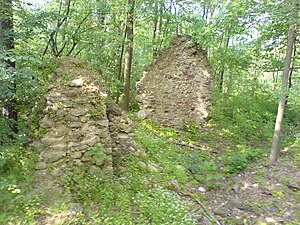Pušperk Castle
| Pušperk | ||
|---|---|---|
|
Remains of the castle |
||
| Alternative name (s): | Puschberg, Fuchsberg | |
| Creation time : | around 1260 | |
| Castle type : | Hilltop castle | |
| Conservation status: | ruin | |
| Place: | Pušperk | |
| Geographical location | 49 ° 26 '6 " N , 13 ° 9' 1.5" E | |
| Height: | 580 m nm | |
|
|
||
The ruins of the Pušperk Castle (German Castle Puschberg , originally Fuchsberg Castle ) are located in the Pušperk district of the Poleň municipality in the Okres Klatovy in the Czech Republic .
geography
The remains of the hilltop castle lie to the west above the village Pušperk on the wooded hill Na Pušperské skále (582 mnm) in the Chudenická vrchovina ( Chudenitzer Bergland ).
history
The castle Fuchsberg was in 1260 by the Viscount of Poděhusy, Jarosch of the Great Sliwno ( Jaroš ze Slivna ) for the protection of the new trade route from Horažďovice about Klatovy , Poleň and Horšovský Týn of Bavaria built. Jarosch received the area that had previously belonged to the domain of the Lords of Drslavice, presumably from King Ottokar II Přemysl for his services in the victorious battle of Kressenbrunn . The original name of the castle was derived from Jarosch's coat of arms, in which he led a fox; However, he was Czechized within a short time. Already in 1264 the lord used in parallel with the predicate of growth Berg also of Puschperk . Jarosch's widow Katharina sold the property to the Hroznata family after 1298 . From 1339 Bušek Hroznata von Pušperk is verifiable as the owner, from 1355 Racek Hroznata von Pušperk followed. In the 1370s, the royal hunter of the Dobříš forests, Ctibor Tlam, acquired the Pušperk estate with the town of Poleň , which he expanded to include the Únějovice estate . Ctibor's son Jan Tlam built a fortress in Únějovice, but he could not hold the Pušperk Castle. In 1388 Sobieslaw von Rudoltitz made a donation to the church in Poleň. King Wenceslas IV left the Pušperk castle to Renvald von Ústupenice in 1390. He managed the property with little profit and finally had to cede it to his main creditor, the Prague Jew Jonas. After his death, the rule of Pušperk fell by reversion to the crown of Bohemia ; King Wenceslaus IV sold it to the brothers Renvald and Bohunek from Ústupenice around 1400. From 1404 Renvald von Ústupenice was the sole owner of the estate. He was followed by his brother Svoješ of Ústupenice, who fell against the Hussites in 1420 in the battle of Vyšehrad . Then the rule fell to Hynek von Ústupenice. The town of Klatovy , which had become a center of the Taborites since 1419 , occupied the dominion belonging to the Catholic Hynek of Ústupenice and had the castle destroyed. In 1434 Hynek von Ústupenice got the rule back, but he did not have the castle rebuilt. After 1439 his widow Ofka inherited the Puschberg estates and later sold them with the desert castle Puschberg to her third husband Dietrich von Čiremperk on Czernikau . After the reversal that occurred with the death of Hynek von Ústupenice was subsequently established in 1457, the Puschberg reign from the possession of Ernst von Hirschstein fell back to the Bohemian crown. King Ladislaus Jagiello gave Puschberg to Johann Zajíc von Hasenburg in the same year . In 1462, he sold half of the manor to Jiřík von Říčany and Dietrich von Čiremperk. The latter sold his stake before 1473 to the Catholics Boženko ( Břeněk ) von Ronsperg, who made the Pushberg Castle the starting point for raids, especially against the utraquist city of Klatovy. In order to restore peace, the castle was captured by an army from Klattau and destroyed again in 1473 with the approval of the Beneschau state parliament. At the end of the 15th century, the Lords Švihovský von Riesenberg acquired the Pushberg estate with the desert castle and assigned it to their rule Švihov .
After the Puschberg estate was separated from the Švihov rulership and sold to Albrecht Nebilovsky von Drahobuz, the castle remained desolate; After 1550 Albrecht Nebilovsky had a fortress built as the new seat of power in Poleň.
At the end of the 16th century, a church dedicated to St. Chapel dedicated to Wenceslas erected; it was abolished in the course of the Josephine reforms at the end of the 18th century and later collapsed.
According to local legends, an underground passage from the Pušperk Castle to the Ruchomperk Castle is said to have led.
description
Only a torso of the castle gate and remnants of the adjacent wall have survived from the castle.

